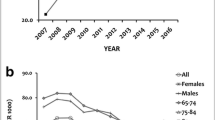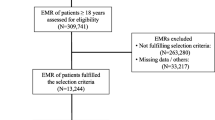Summary
Introduction
Cardiovascular diseases remain the major cause of death in the world, with extensive public health expenditures. Lipid lowering agents are widely used for prevention, among which statins are dominant. The statins market is steadily expanding in Italy. It is however possible that some prescriptions are not justified; as well as, on the other hand, that consumption does not meet the necessary compliance. Confronting such questions, the present work performs a drug utilisation study of statins in Italy, according to current practices and in the perspective of the compliance to treatment.
Materials and methods
Observational data were collected in a Health Unit located in Northern Italy, via its administrative database. Patients were considered eligible who had received at least one prescription of statins in the course of the five years period 2000–2004. The drug utilisation was evaluated year by year and in different ways, that is: 1) by the RDD (Received Daily Dose), which is an indicator of the average quantity of drug actually received by a patient; 2) by the PDD (Prescribed Daily Dose), an indicator of the intention to treat by the practitioner in charge; 3) by the number of days of treatment per year, calculated based both on DDDs (Defined Daily Dose, i.e. the World Health Organisation standard for the daily intake of a drug) and PDDs.
Results
40,583 patients were recruited (mean age 61 years, 47% males). A 44% drop-out was assessed among patients in their first year of treatment. Average RDDs resulted generally lower than the respective DDDs, all RDDs showing a positive growth trend. The same positive trend was observed with PDDs, which, on the other side, were always higher than the respective DDDs. The general average value for days of treatment was 248 (when calculated based on DDDs). Also such parameter was steadily, substantially growing along the years of the observation period. The analysis of compliance (measured in terms of days of treatment as percent of 365 days in a year) showed that the share of patients was decreasing with a compliance until 50%, constant with a compliance 50 to 75%, and increasing with a higher compliance.
Discussion and conclusions
Several studies are available where compliance is estimated with reference to one point in time (e.g. one year). Though valuable, this is static information. On the contrary, a potential contribution by the present study is in having analysed the drug utilisation of statins also in its dynamics, so providing data not only about levels but also about trends. On this issue, one could agree there is a general, positive tendency in Italy towards a more correct treatment practice; this is shown by drug utilisation increasing levels, which are approaching those recommended for therapeutical efficacy.
Similar content being viewed by others
Bibliografia
National Center for Chronic Disease Prevention and Health Promotion. Preventing heart disease and stroke (online: www.cdc.gov/nccdphp/bb_heartdisease/index.htm)
Task Force for Compliance. Non compliance with medication regimens: an economic tragedy: emerging issues in pharmaceutical cost containing. Washington, DC: National Pharmaceutical Council, 1994: 1–32
McGhan WF, Peterson AM. Pharmacoeconomic impact of noncompliance. US Pharmacist Impact 2001: 3–13
Stamler J, Wentwoeth D, Neaton JD. Prevalence and prognostic significance of hypercholesterolemia in men with hypertension: prospective data on primary screens of the Multiple Risk Factor Intervention Trial. Am J Med 1986; 80(2A): 33–9
Downs JR, Clearfield M., Weis S, et al. Primary prevention of acute coronary events with lovastatin in men and women with average cholesterol levels: results of AFCAPS/TexCAPS. Air Force/Texas Coronary Atherosclerosis Prevention Study. JAMA 1998; 279(20): 1615–22
Shepherd J, Cobbe SM, Ford I, et al. Prevention of coronary heart disease with pravastatin in men with hypercholesterolemia. West of Scotland Coronary Prevention Study Group. N Engl J Med 1995; 333(20): 1301–7
Scandinavian Simvastatin Survival Study Group. Randomised trial of cholesterol lowering in 4444 patients with coronary heart disease: the Scandinavian Simvastatin Survival Study (4S). Lancet 1994; 344(8934): 1383–9
The Long-term Intervention with Pravastatin in Ischaemic Disease (LIPID) Study Group. Prevention of cardiovascular events and death with pravastatin in patients with coronary heart disease and a broad range of initial cholesterol levels. N Engl J Med 1998; 339(19): 1349–57
Wei L, Wang J, Thompson P, et al. Adherence to statin treatment and readmission of patients after myocardial infarction: a six year follow up study. Heart 2002; 88(3): 229–33
Avorn J, Monett J, Lacour A, et al. Persistence of use of lipidlowering medications: a cross-national study. JAMA 1998; 279(18): 1458–62
DM del 22/12/2000 (Suppl. Ord. alla G.U. del 10/01/2001)
Peterson AM, McGhan WF. Pharmacoeconomic impact of noncompliance with statins. Pharmacoeconomics 2005; 23(1): 13–25
Abraha I, Montedori A, Stracci F, et al. Statin compliance in the Umbrian population. Eur J Clin Pharmacol 2003; 59: 659–61
Larsen J, Andersen M, Kagstrup J, Gram LF. High persistence of statin use in a Danish population: compliance study 1993–1998. Br J Clin Pharmacol 2002; 53(4): 375–8
Commissione Terapeutica Regionale, Regione Toscana. Elementi di criticità nella prescrizione toscana delle statine. Riflessioni sul farmaco 2005; 2: 3–5
L’Informatore Farmaceutico. Milano: OEMF, 2005
IMS. Statistiche di mercato, anni 2000–2004
Walley T, Folino-Gallo P, Stephens P, Van Ganse E, on behalf of the EuroMedStat group. Trends in prescribing and utilization of statins and other lipid lowering drugs across Europe 1997–2003. Br J Clin Pharmacol 2005; 60(5): 543–51
Howell N, Trotter R, Mottram DR, Rowe PH. Compliance with statins in primary care. Pharm J 2004; 272(7281): 23–6
Wong IC, Mawer GE, Sander JW, Lhatoo SD. A pharmaco-epidemiologic study of factors influencing the outcome of treatment with lamotrigine in chronic epilepsy. Epilepsia 2001; 42(10): 1354–8
Lhatoo SD, Wong IC, Polizzi G, Sander JW. Long-term retention rates of lamotrigine, gabapentin, and topiramate in chronic epilepsy. Epilepsia 2000; 41(12): 1592–6
Deambrosis P, Saramin C, Terrazzani G, et al. Pharmacoepidemiology of statin treatment: a follow up study of ten years. Abstract presentato al 32∘ Congresso Nazionale SIF. Napoli, 1–4 giugno 2005
De Ambrosis P, Saramin C, Terrazzani G, et al. Dieci anni di utilizzo delle statine: adesione alla terapia e costi del trattamento farmacologico. Pharmacoeconomics-Italian Research Articles 2005; 7(3): 187–94
Benner JS, Glynn RJ, Mogun H, et al. Long-term persistence in use of statin therapy in elderly patients. JAMA 2002; 288(4): 455–61
Author information
Authors and Affiliations
Corresponding author
Additional information
I peer reviewers, per questo articolo, sono stati coordinati da Andrea Messori.
Rights and permissions
About this article
Cite this article
Lucioni, C., Mazzi, S., Cerra, C. et al. Uno studio di drug utilisation delle statine nella recente prassi terapeutica italiana. Pharmacoeconomics-Ital-Res-Articles 8, 3–17 (2006). https://doi.org/10.1007/BF03320554
Published:
Issue Date:
DOI: https://doi.org/10.1007/BF03320554




